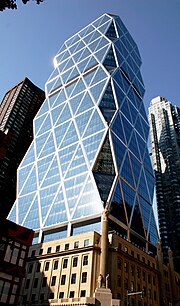Leadership in Energy and Environmental Design

The Leadership in Energy and Environmental Design ( LEED , translated as leadership in energy and environmentally friendly planning ) is a system for classifying ecological building that was developed by the US Green Building Council in 1998. It is a sustainability certification used worldwide and defines a number of standards for environmentally friendly, resource-saving and sustainable building.


Certification
In the LEED v2.2 version for new buildings and major renovations of commercial properties, there are 69 points to be awarded and the buildings can be classified into 4 quality levels:
- Certified : 26–32 points
- Silver : 33–38 points
- Gold : 39-51 points
- Platinum : 52–69 points
In 2009, the previously valid version LEED v2.2 was replaced by LEED v3 (LEED 2009). In 2013 the latest version LEED v4 was published. In the current set of rules, 110 points can be achieved:
- Certified : 40–49 points
- Silver : 50–59 points
- Gold : 60-79 points
- Platinum : 80 and more points
This distribution of points applies to all system variants of LEED certification. Buildings of various uses can be certified as part of the variants Building Design + Construction, Interior Design + Construction, Existing Buildings - Operations & Maintenance, Neighborhood Development and Dynamic Plaque. With LEED v4, real estate is rated on the basis of various criteria in the categories location and traffic, sustainable location, water efficiency, energy and atmosphere, materials and raw materials, interior quality and comfort as well as innovation and regional priorities.
In Germany, the German Green Building Association eV (GGBA) has been the official partner of the US Green Building Council (USGBC) since 2012 and is therefore the responsible contact person for the entire DACH region at national level.
Accreditation bodies
"Green Building" experts can be accredited through the LEED Accredited Professional Exam . This accreditation authorizes a person to carry out the assessment and certification of buildings according to the various LEED systems. The accreditation is administered by the Green Building Certification Institute .
Other national rating systems
- LEED international
- German seal of approval for sustainable building
- LENOZ ( Le tzebuerger No haltegkeets- Z ertificate) for residential buildings in Luxembourg
- Minergie in Switzerland
- HQE in France
- CASBEE in Japan
- Estidama in UAE
- GREEN STAR in Australia
- BREEAM in the UK
- BEAM in Hong Kong
For a general description of national developments see article Green building .
criticism
The LEED standard often uses US standards, which are little known in Europe. For some time now, German engineering offices have been offering calculations based on US standards. In order to achieve the LEED standard, global measures are defined, which may then be unnecessary when viewed regionally (e.g. rainwater use or gray water use in areas with high rainfall). Building technology measures are also required that are counterproductive (e.g. air exchange rate of 100 m³ / h with mechanical ventilation ( air conditioning ) in toilets, where half - with half the energy consumption and only 70% investment costs - would be sufficient.)
See also
- Ecological Footprint
- Energy saving
- Green building
- Permaculture
- Renewable energy
- Zero energy house
- Climate policy
Web links
- US Green Building Council (English)
- World Green Building Council (English)
- Canada Green Building Council (English)
- Leed Certified Real Estate (English)
- LEED system description from the Institute for Applied Energy Simulation and Facility Management
- GGBA | German Green Building Association
- DGNB e. V. - German Society for Sustainable Building
